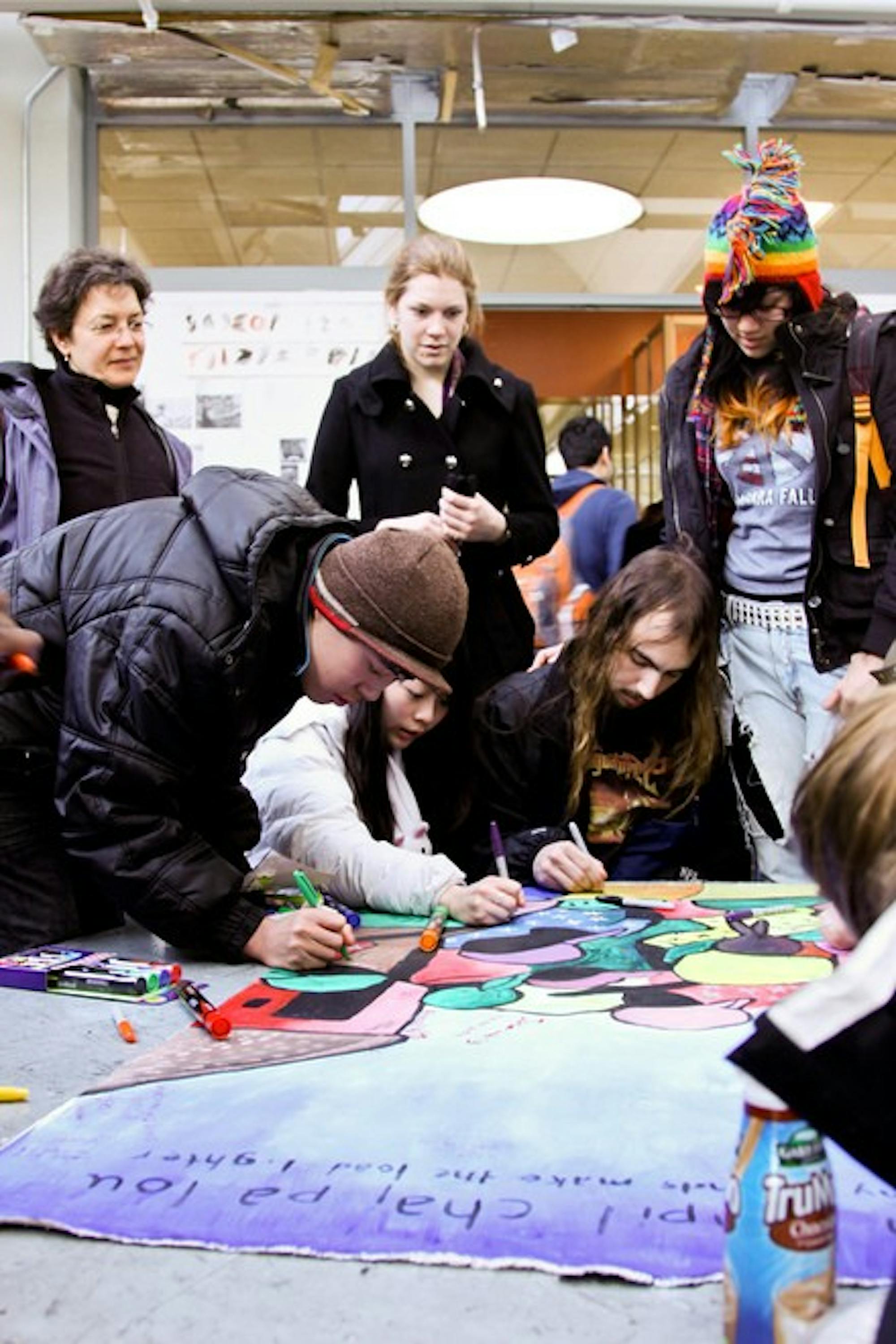"We're not doctors or activists or economists," director Chiara Klein '10 said. "We can't go to Haiti to help, as much as we want to. What can we do? We can perform, we can use our skills as artists to at least try and help."
Klein and Tom Leddy-Cecere '10 community outreach and publicity coordinator for the event both said they saw "Compas" as the ideal way to employ their skills in a meaningful way to aid the relief effort in Haiti. Klein also said she loved the idea of uniting students on campus through the arts.
"This show really represents a cross-section of campus coming out of the woodwork to come together and perform for a wonderful cause," Klein said.
Alex Schindler '10, a co-chair of SDHR who performed with the Dartmouth College Glee Club at Sunday's event, called performing in the show "a very powerful experience."
"Putting people who had never performed together up on one stage exemplified the unity of the Dartmouth campus in response to [the disaster in] Haiti," Schindler said.
Rudee Lipscomb '08, the creative force behind the show, according to Klein and Leddy-Cecere, came up with the concept for the concert just 15 days ago at an early organizational meeting of SDHR.
The idea for a performance-oriented Haiti fundraiser is not entirely unprecedented, as other events have been held over the past two weeks that have raised several hundred dollars each for Haiti relief, according to SDHR chairs.
Sunday's show, however, was both the most recent and the largest-scale iteration of the formula.
Klein acknowledged that, in the beginning, Lipscomb's idea was "exciting but crazy." Bringing together upwards of 200 performers from nearly two dozen student performing groups in a coordinated concert in two weeks' time was an ambitious undertaking, she said.
In the end, Klein said she was pleasantly surprised with her "15-day adventure."
"[The coordination process] was surprisingly okay," Klein said. "Things came together really well. Everyone was excited by the crazy ideas that we had [for mash-ups and other joint performances]."
Leddy-Cecere agreed, noting that everyone's attitude has been "fantastic."
"From the start, the ensembles have made clear that it's not about us,' that they are here to help people using the skills that they have," he said.
According to Klein, the key to getting so many groups on board lay in calling very few rehearsals they had only one routine rehearsal and one full tech rehearsal. The producers also told groups that they could perform pieces they already knew. After grouping ensembles based on "who would be cool together," Lipscomb and Klein asked one ensemble to give them whatever they deemed appropriate from their repertoire. The partner group or groups would then be asked to come up with something complementary.
"We then tried to blend everything, and with a little luck, everything worked out," Klein said.
While Sheba choreographed a unique dance for "Compas," and the College's nine a capella groups jointly learned John Lennon's "Imagine," the remaining performances drew on existing material and were blended in creative ways. The Glee Club performed Mozart's "Requiem," which, billed as a mash-up, segued into a showcase of Ujima's dance musings. The Dartmouth Wind Symphony joined Fusion Dance Ensemble and step group Staccato for a lively rhythm competition in the spirit of a dance-off. The Dartmouth Dance Ensemble also added a visual complement to the beats of the World Music Percussion Ensemble. The theater department brought together the on-campus members of its 2008 Mainstage production of "Hair" to perform alongside Sheba for a raucous and entertaining finale.
Leddy-Cecere pointed out that the Hop was very accommodating and that it was their support that ultimately allowed "Compas" to be a professional-grade production.
"The Hop was booked solid, but they made room for us in their best venue," Leddy-Cecere said. "Thanks to [Student Assembly], they were also able to provide us with a full technical production staff on Saturday and Sunday. It was great."
Student Assembly provided $3,500 to cover the technical costs for union labor at the Hop, according to Student Body Vice President Cory Cunningham '10. Thanks to the donation, 100 percent of the proceeds from ticket sales could go directly to Partners in Health. Student tickets sold for $10, while the general public paid $20 for a seat.
Cunningham is a former member of The Dartmouth Senior Business Staff.
Excluding the 200-plus student performers associated with the production, just under 300 tickets were sold, short of Spaulding Auditorium's 900-seat capacity.
Despite a somewhat underwhelming turnout, Klein stressed the experiential benefits of "Compas" for all involved.
"This has been a great experience in terms of philanthropy and the arts. Out in the real world, you need to create opportunities and use your skills to rally the community, which is exactly what we have been able to do with this show," she said.
While "Compas" was largely the domain of the performing arts on campus, visual arts students contributed to relief effort by collaborating on a "Community Mural for Haitian Relief." From 12:00 p.m. to 12:00 a.m. on Saturday, the drawing studio in the Hop was open to artists and non-artists alike to facilitate the creation of two murals to be sent to the Partners in Health offices in Haiti. The "Compas" audience was encouraged to stop by the drawing studio, which reopened after the show to allow more people to contribute their own thoughts and designs.




